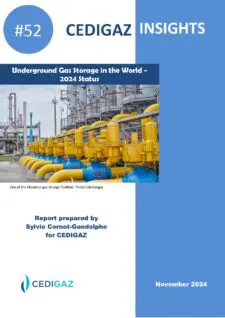
Underground Gas Storage in the World - 2024 Status
| Non Member | 1200 € | |
| Member | FREE | Login |
In an era marked by fluctuating energy markets and geopolitical tensions, the importance of underground gas storage (UGS) has never been more pronounced. As the backbone of global gas security, UGS facilities play a critical role in balancing supply and demand, mitigating price volatility, and ensuring a stable energy supply during peak consumption periods. The recent global gas crisis has thrust UGS into the spotlight, prompting accelerated growth and renewed investment in this vital infrastructure.
By the end of 2023, the global working gas capacity of UGS reached 437 billion cubic meters (bcm), a 2% year-on-year increase—the largest since 2015. This surge is primarily due to significant capacity expansions in China, with additional contributions from Europe, Kazakhstan, and Canada. The number of operational UGS facilities globally stood at 681, with China commissioning five new facilities and Saudi Arabia adding its first. The global peak withdrawal rate also increased by 1.6% to 7,516 million cubic meters per day (mcm/d).
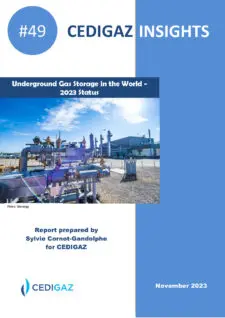
Underground Gas Storage in the World - 2023 Status
| Non Member | 990 € | |
| Member | FREE | Login |
The CEDIGAZ 2023 report highlights significant shifts in the global gas market, with a 1.3% increase in Underground Gas Storage (UGS) capacity, driven by the global gas crisis. Major contributors include China and Europe, with a focus on expanding storage in rapidly developing markets like the Middle East. The report notes a 20% growth in UGS projects in 2022, reflecting the sector's growing importance in natural gas supply security.
The global energy crisis, especially due to Russia's invasion of Ukraine, has reshaped the gas market, leading to more flexible and price-sensitive LNG trade. Governments globally are focusing more on natural gas security, introducing stricter storage regulations and strategic LNG reserves. Japan proposed an international cooperation framework to enhance LNG security.
Europe's RePowerEU plan, a response to Russian aggression, seeks to lessen reliance on Russian fossil fuels, mandating higher gas storage levels. In 2022, storage exceeded EU regulations, reaching 95% by November. Other regions, including Ukraine, the US, China, and the Middle East, are also advancing in UGS, adapting to their specific market needs.
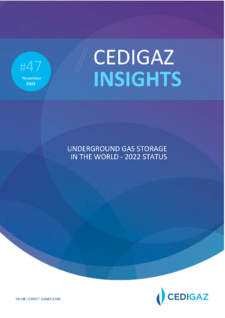
Underground Gas Storage in the World - 2022 Status
| Non Member | 750 € | |
| Member | FREE | Login |
This annual report assesses underground gas storage (UGS) in the world at the end of 2021. It is based and complemented by a comprehensive online database, including detailed statistical information on current and future capacities for the 667 UGS facilities in operation in the world and the 166 UGS projects under construction, planned or potential. Altogether, the database includes 51 countries. The database also includes information on closed, mothballed and inactive UGS facilities, as well as the expansion stages of UGS facilities, when this information is available (see Methodology). The database is available to CEDIGAZ’s members under the infrastructure section of CEDIGAZ website.
This report includes two parts. The first one gives an assessment of UGS capacity at the end of 2021 and new capacity under construction, planned and potential. The second part reviews major trends in UGS in selected key markets: Europe, Ukraine, Russia, the United States, and China. In view of the crucial role of gas storage for security of supply, this review includes an analysis of gas stocks in 2021/22 and winter 2022/23 preparedness. In addition, recent UGS construction activity is reviewed in Central and South America and the Middle East.
This report is based on information available at the beginning of November 2022.
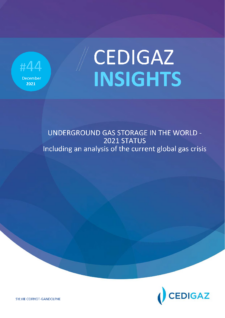
Underground Gas Storage in the World 2021 Status
| Non Member | 500 € | |
| Member | FREE | Login |
This annual report assesses underground gas storage (UGS) in the world at the end of 2020. It is based and complemented by a comprehensive online database, including detailed statistical information on current and future capacities for the 661 UGS facilities in operation in the world and the 91 new projects under construction, planned or potential. Altogether, the database includes 51 countries. The database also includes information on closed, mothballed and inactive UGS facilities, as well as the expansion stages of UGS facilities, when this information is available (see Methodology). The database is available to CEDIGAZ’s members under the infrastructure section of CEDIGAZ website.
This report includes three parts. Due to the exceptional events on the gas (and energy) scene in 2021, this year’s report includes an analysis of the main causes of the elevated European and North Asian spot gas prices (Part 1). Then, the report gives an assessment of UGS key metrics in 2020 and their evolution compared to 2019. The third part reviews major trends in UGS in selected key markets: Europe, Ukraine, Russia, USA, and China. In addition, recent UGS construction activity is reviewed in South and Central America and the Middle East.
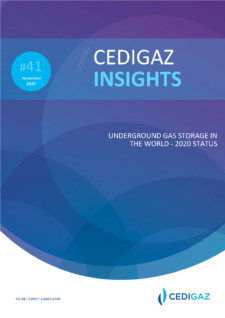
UNDERGROUND GAS STORAGE IN THE WORLD - 2020 STATUS
| Non Member | 150 € | |
| Member | FREE | Login |
The dramatic developments in gas markets in 2019-2020, with an acute oversupply situation due to the negative impact of the COVID-19 pandemic on demand and compounded by the massive increase of LNG supply from the US has stressed the fundamental importance of European Underground Gas Storage, assisted by Ukrainian UGS, to alleviate the imbalance of global gas markets. While until recently, UGS has mainly been developed in North America, Europe and the C.I.S., China is now on the fast lane for storage development. Russia, although the second global UGS capacity holder is still developing its storage infrastructure to serve both domestic and export markets.
This new report by CEDIGAZ provides an insightful review of storage activity in 4 key markets in 2020 and highlights the crucial role of UGS in balancing the global gas market as well as increasing security of gas supply in the context of rising geopolitical risks and trade tensions. The report also includes data on operating, under construction and planned facilities detailed by country.
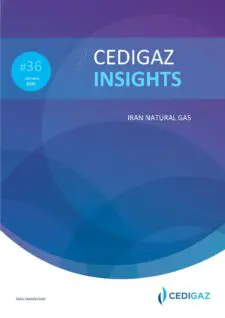
IRAN NATURAL GAS
| Non Member | 1200 € | |
| Member | FREE | Login |
Iran has one of the largest proven natural gas reserves in the world, hosts about 17% of the world’s proven natural gas reserves. Iran is also the world’s third–largest dry natural gas producer after the United States and Russia.
This report Dr Sara Vakhshouri founder and president of SVB Energy International and renown specialist of the Iranian energy sector provide an update of Iranian Gas Chain under US sanctions
Contents:- Historical background
- Gas reserves & Exploration
- Development & Production
- Gas Refining & Production at Refineries
- Natural Gas Consumption, Import & Export
- Underground Gas Storage
- Gas Condensate Production
- Implication of US sanctions
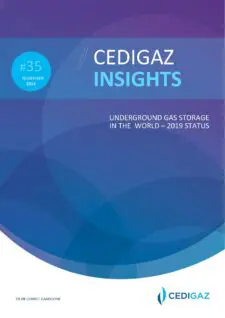
Underground Gas Storage in the World - 2019 Status
- At the end 2018, there were 662 underground gas storage (UGS) facilities in operation in the world. The global working gas capacity reached 421 bcm
- North America concentrates more than two thirds of the sites and accounts for almost 40% of global working gas capacity and half of global deliverability, the top five countries (United States, Russia, Ukraine, Canada and Germany) account for 70% of the worldwide capacities
- Storage in depleted fields dominate with 79% of global working gas volumes, but storage in salt caverns now accounts for 26% of global deliverability
- In 2018, the growth in gas storage capacity contrasted with the trends observed since 2015
- At worldwide level, there are 102 identified projects at different stages of planning
- UGS development activity is dominated by China, which alone accounts for almost half of the 37 bcm of working gas capacity under construction
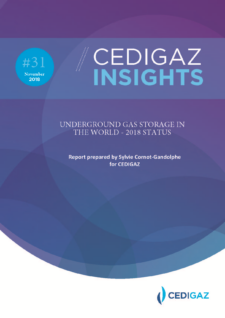
Underground Gas Storage in the World - 2018 Status

Overview of Underground Gas Storage in the World 2017–Status

Underground Gas Storage & LNG Storage Market in the Word 2015-2035
CEDIGAZ publications
- Biogas - Biomethane - Green Gas
- CCS - Carbon Capture and Storage
- CEDIGAZ Insights
- Country Report
- Energy Transition
- First Estimates
- Free downloads
- Gas-Coal Competition
- Hydrogen
- LNG Markets
- Natural Gas Markets
- Natural Gas Statistics
- Outlooks
- Small Scale LNG
- Thematic reports
- UGS - Underground Gas Storage
- Zero Carbon Gas



